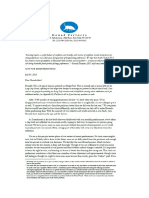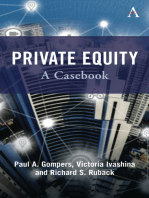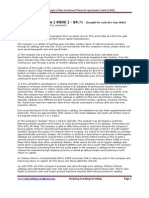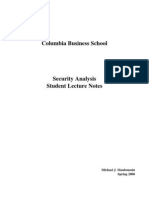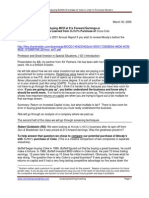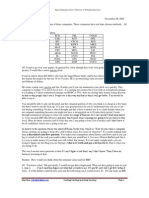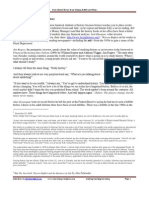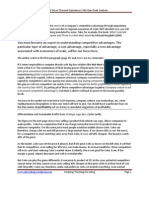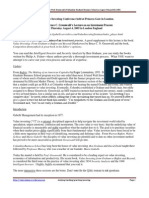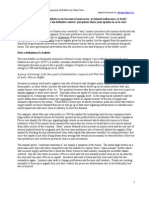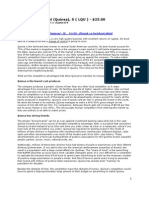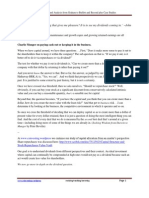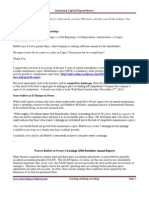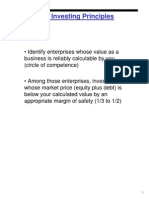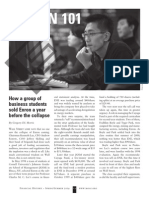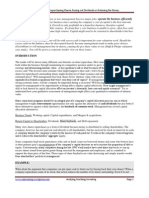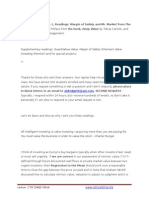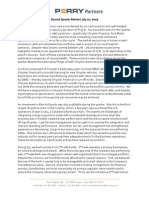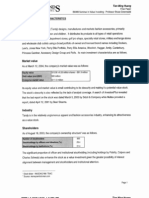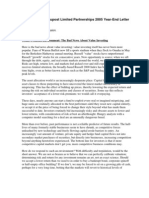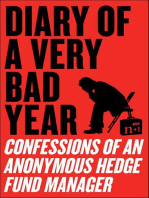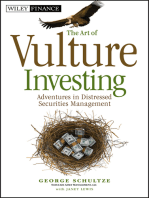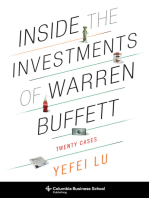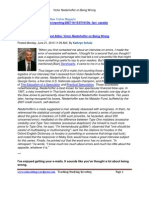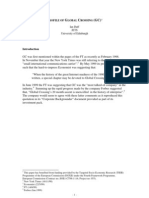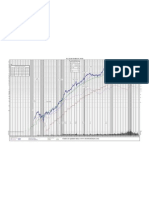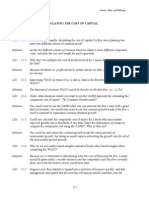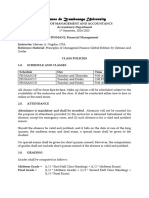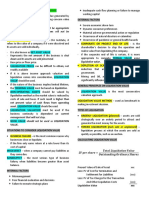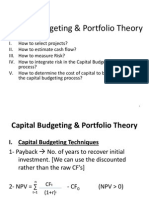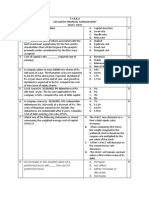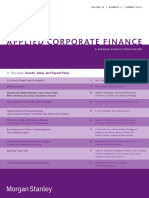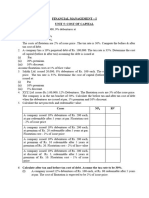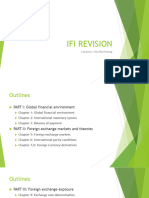Greenwald Class Notes 6 - Sealed Air Case Study
Greenwald Class Notes 6 - Sealed Air Case Study
Uploaded by
John Aldridge ChewCopyright:
Available Formats
Greenwald Class Notes 6 - Sealed Air Case Study
Greenwald Class Notes 6 - Sealed Air Case Study
Uploaded by
John Aldridge ChewCopyright
Available Formats
Share this document
Did you find this document useful?
Is this content inappropriate?
Copyright:
Available Formats
Greenwald Class Notes 6 - Sealed Air Case Study
Greenwald Class Notes 6 - Sealed Air Case Study
Uploaded by
John Aldridge ChewCopyright:
Available Formats
Greenwald Class #2 January 27, 2004 Sealed Air
Valuation of Sealed Air (complicated valuation) This class is an introduction to a relatively long-term educational process. We are introducing a standard systematic approach for your own mental furniture to enable you to learn to be truly outstanding value investors and ultimately very rich. I hope it will not happenis the increased selectivitywill discourage you. The Columbia Alumni do extremely well in life. Remember that there is no formula in life. All the empirical evidence show that grades dont matter. Being tall and good-looking matters more than doing well in your courses. After you turn in your work and after you have made a serious effort and we have discussed it in class, you have a sense of a developing way of going at and finding and valuing these securities. That is much more important than how close your analysis is to my example. I am going to go through this Sealed Air valuation. I dont expect that you would have nailed your valuation. What we are doing: We give you the security. (Students can choose the retail company they wish to value). For the Retail Exercise, you will choose the security that could be undervalued. As you correlate your evidence, we want you to look for any systematic biases, any confirmatory evidence so you id where the uncertainty lies and the risks inherent in buying these securities. Sealed Air is a complicated company because of the Cryovak merger. It is hard to get a sense of what the joint entity is. On the other hand, whenever you are faced with a difficult problem like that, you need to break the problem down into pieces. Look at the component parts and go as far as you can. Start with the Old Sealed Airvalue that. See what it would be worth pre-merger. Then look at the merger in terms of what they are paying and what they are getting and see the extent to which the merger adds to and subtracts to this underlying value. And see if you wind up with a broadly consistent story of what is going on. Start with broad brush views. There are some good signs. There is a stock buyback. Management has a terrific record of performance. At the end of 1997, the stock is at $60 and in 1998 the stock is down. TRADITIONAL VALUATION METRICS Start off with traditional valuation. First thing is to separate it from your valuation analysis. What would it cost to buy this company in the market? What is the total market www.csinvesting.wordpress.com teaching, studying, investing Page 1
Greenwald Class #2 January 27, 2004 Sealed Air
capitalization value of the company? There are 42.8 mil at $60 = $2.5 to $2.6 billion in market cap and in $75 million debtso the enterprise value is $2.6 to 2.7 billion. There are traditional measures to see if this stock is cheap. The book value of this stock is $257 million, and then add the $75 million of debt to get $332 million or the book value is 1/8th of the market value of the company. Right away what is that going to tell you? There is not much asset value here. This is a case where you are buying a franchise here. Earnings were $80 million. P/E of the Enterprise is 32x. You can do comparisons to other records. They describe themselves as a specialty chemical company which trade at about 30 x earnings thus giving Sealed Air a valuation of $2.4 billion (close to enterprise value of $2.6 Billion) or $55 per share. You can do comparison to other companies. Sealed Air also has packaging operations which trade at 20 xs, which would give you a value of only $1.6 Billion or $37.4 per share. In terms of earnings that this is a stock is richly priced and based on the multiple analyses between 20 xs and 30 xs, that there is a tremendous amount of uncertainty about the valuation of the stock. The price to enterprise value is 32 xs. You can do EBIT multiples. EBIT was $138 million or a multiple of 19 if you divide it into the Enterprise Value Packaging companies typically have EBIT multiples of 13 which gives you a value of $1.8 billion. Specialty Chemicals have an EBIT multiple of 18-20 which give you a $2.5 billion. Or you can do a cash flow multiple, EBITDA multiple (assumes no cap-exwhich is a bad assumption). EBITDA is $184 million that is a 13 multiple. Packaging companies typically trade at 9 times. Specialty Chemical Companies trade between 12x and 14x EBITDA, which gives you a value of $2.2 to $2.4 billion. EBITDA (Maintenance Cap-ex + change in NWC) = $148 million (pre-tax) as distributable cash flow in those terms, treating investment as $0--A CF multiple of 28. With a tax of $54 million, you have $94 million after-tax profit. The multiple is 25x 26 xs. The growth rate is 50% and a cost of capital is 10%. The multiple you are going to apply is 25. 25 x $94 million = $2.35 billion. On the other hand, this is a stable company so the cost of capital might be 8%. If you apply a growth rate of 6% then $94 million/ (8% - 6%) = $94 million/.02 = $4.7 billion or $109 per share! A bargain company in those terms. At the other extreme with a cost of capital is 12% and growth rate of 6% = $94 M/.06 = Approximately $1.6 billion. A multiple is 17. www.csinvesting.wordpress.com teaching, studying, investing Page 2
Greenwald Class #2 January 27, 2004 Sealed Air
Even before you do any calculation we have $1.6 billion to $4.7 billion value range with the traditional valuation metrics. Too wide to be of much use. A quick and dirty DCF: 37.5% tax rate, an after-tax return of 10%. NWC 10% of sales, fixed capital is 27.5% of sales37.5% of sales. Historical growth rate is all over the lot. You could extrapolate at 10%. If you do that the CF is 10% after-tax margin on sales minus what you have to reinvest which is the 10% growth rate in sales x 3.25 cents for each dollar growth in sales. A net return of 6.25% of sales. At a WACC of 12% and a growth rate of 10%, the multiple is 50x or 1/.02%. If you did NPV calculations you would have come up with about $2.7 billion. Where does the traditional valuation leave you? It is not particularly useful. Management is there, but the valuations are all over the lot. Management and Directors own 6.3%. There has been recent insider selling. This is the information a traditional analyst would throw up. Part 2: Go through the value procedure to see if you get a clearer view. When I do a value approach where do I start? A search strategy. I will ask retrospectively, How closely does Sealed Air fit as the sort of company where are going to be on the right side of the trade? We would ordinarily look for small--$2.4 to $2.7 billion in price so Sealed Air is not small. NEGATIVE We are looking for cheapMkt to book of 8 and P/E of 30, so it is not cheap. NEGATIVE We are looking for non-glamourthis is a bubble wrap company and it has gotten a lot of attention due to the Internet and more mailings. This is not an obscure or undesirable company. There at the time glamour elements to this business. NEGATIVE HISTORY More importantly, this is a company that had a history of getting in bed with major investors and doing very well for those important shareholders. This is not a company that was overlooked in any sense by sophisticated investors. In 1989 the CEO was annoyed with his stock price. The bubble wrap was coming off patent; the stock was trading at 9 x earnings--$20 per share.
www.csinvesting.wordpress.com
teaching, studying, investing Page 3
Greenwald Class #2 January 27, 2004 Sealed Air
He decided to borrow money and declare a one time dividend to shareholders of $20 per share. He gave the stockholders all their money back. I think I can handle this debt without going bankrupt. He is putting his money where his mouth is. After the recapitalization, the stock is at $5.00 per share, and then two years later the stock is at $12.00. He delivered on his promises to generate cash flow and pay down debt. If you kept the stub you made 55% per year. 1990 was not a good year for the stock market. What is the most important thing for managementnot losing their job. The empirical evidence shows that when management makes a large dividend to shareholders then they are confident. A good sign. The CEO was saying the growth prospects were not good for Sealed Air, which the market already knew, but he was confident in the profitability of the business. He was really putting his money where his mouth is. In 1993, the stock goes from $12 to $15. In 1993 he makes a big acquisition because he has shown he can pay back debt. He stops paying dividends because he says he can grow the business and do well. What is your predisposition at the end of 1993, you believe himthe stock goes up from $15 to $50. Management has delivered in spades. Is this a stock that is likely to be overlooked? No. Are there big investors close to management? Yes. As an outside value investor, are you like to be the smart one in the trade here? No you are not. You are the dumb money. This is a broadly visible stock with very smart people close to managementwhere is your edge? You must take this into account. NEGATIVE Where are the major shareholders at the end of 1997? They are out of the stock. FMR is only one that is left. Why are insiders selling? To pay for their daughters wedding, to buy a new house, to pay for college. If they thought the stock was going up, they would borrow money against their sealed air stock. Nothing about this company says value. Nothing says that in buying stock like this, you ought to expect to be smarter than the anonymous person on the other side of the trade. That is the starting point from all the other analysis that you made. I hope everyone did something like that in the case of Sealed Air. You looked at how expensive the stock was, the history of the stock and the exposure. Neither Liz Claiborne nor Hudson General fit the glamour profile of Sealed Air. Now that is not the end of it. You might still be willing to look at this to see if in sometime in the future, it is worth buying. But remember what we are trying to teach you to do here is to do this systematically. The next step is to value Sealed Air. Go to the asset value on the balance sheet. www.csinvesting.wordpress.com teaching, studying, investing Page 4
Greenwald Class #2 January 27, 2004 Sealed Air
35 mil. Cash 132 A/R + $6 mil. for doubtful accounts = $138. Inventory + $4 million LIFO reserve = $63 Other is $8 million Reproduction Value of $260 current assets vs. $250 book value -- Not much change here Land and leasehold improvements $171 Land in Northern NJ. Worth at least $100 million. $250 million in equipment then cut it into two = $125 million, so total is $225 million for PP&E or $54 million above the book value. Intangibles: Product portfoliono patent protection. No P, just R. Patents 3 yrs. R&D = $15m per year for 3 years = $45 million. Be generous, use 5 years. Goodwill is $42 million adjusted by $71 million = $115 The other intangible is customer relationships so 8 months of SG&A = 120 m or full year is $172 million. Other is $24 million Total Assets: $670 Liabilities $156 Net Assets $514 Per share value = $7.75 Book Value, $12 for reproduction value. Market Price is currently 5x the reproduction value! Notice what I started withthe intangibles. How much would a competitor have to spend to establish an equivalent global position to Sealed Air. What are the real assets would I have to carry to look like Sealed Air. For Liz Claiborne it was brand recognition among consumers and relationships with stores and with the clients. Consumer relationships are more difficult to establish than the relationships with shipping companies for Sealed Air. Start with real assets. Take $10 million off for deferred taxes. With all the quick and dirty adjustments and calculationsthe $332 million to an adjusted $500 million but it could be as high as $700 million. Look at the valuation from independent perspectives. What is the first independent perspective--the cost of reproducing the assets. We are not looking at earnings power or franchise value. I first look at what the company consists off: a bunch of factories, an office, product portfolio and a sales force that is positioned with Amazon and big catalog companies. Look from independent perspectives and then put it together.
www.csinvesting.wordpress.com
teaching, studying, investing Page 5
Greenwald Class #2 January 27, 2004 Sealed Air
There is a fairly unambiguous conclusion here. What is the value of the company as a whole? The market value of the company is somewhere between $2.6 to $2.7 billion. How much asset value protection do you have? Very little. The first conclusion is what you saw with the market to book ratio. You are buying a lot of air here. Right away what does that tell you about the risk you are takingthe risk of an existence of a franchise. This asset value is not even close to the market value. This is an important piece of information that you want to look at independently. Remember the emphasis in valuation: knowing what you are buying. We segment the information to look at what we are getting here. Are we going to waste a lot of time on the asset valuation? No. No asset protection there. NEXT STEP: The earnings power value. Dont contaminant this analysis with your asset valuation. You want to correlate the two afterwards by looking at the quantitative strength of the franchise and the actual strength of the franchise. EPV: We will start by looking at the pattern of returns to see if there are any cyclical or secular trends we have to adjust for. We have the last five years of operating margins from the 10-K. They have a fairly stable history of earnings. Their operating margins start with 16.4% and ends with 16.3%, and an average of 16.3%. What is a bad year? 15.1%. Those EBIT margins are checked by the Value Line Operating Margins are actually EBITDA margins. The history is longer. The margins are higher but they approximately track what we havevery stable. Between 1988 and 1990 what has mgt. done? He has increased his margins from 16% to 21%. No problems in the 1991 recession. This is not a cyclical company. No earnings adjustments needed. Any significant positive or negative trendsa slight positive trend. We stick with a high operating margin. There are no large accounting adjustments. There are no unconsolidated subsidiaries. I dont have to do a lot of adjusting to go from current earnings to a measure of earnings power. This is a nice stable business. Now we only have to make an adjustment for excess depreciation. How do I replace the sales force? I hire and train new people, since it has been expensed, then this must be added back. Sustainable Earnings = what you could give to shareholders without hurting the competitive, economic position for the company at the end of the year from where it was at the beginning of the year.
www.csinvesting.wordpress.com
teaching, studying, investing Page 6
Greenwald Class #2 January 27, 2004 Sealed Air
EBIT maintenance cap-ex = true distributable cash flow is greater than reported. Depreciation I based on historical cost. What is the cost to replace buildings (over depreciation) and new machinery (cost to replace going down due to new technology) If the company had been through a big inflationary period overstate CF because depreciation is less than replacement cost. Buy $100 million of equipment then depreciate straight-line over 5 years = $20 million but replacement is $60 million for new equipment then depreciation over 5 years = $12 million. Adjust for excess depreciation. 1997 CF statement shows investment of $45 million Cap-ex is $24 million. Sales increase by $53 million from 1996 to 1997 and there is some investment for increasing of sales. $0.275 PPE for $1 sales. Growth Cap-ex. $27.5 cents x $53 million = $24 million then - $14 million for growth cap-ex = $10 million for maintenance cap-ex. Understand profit. Growth in sales and increase in intangibles for some expense for training in going for growth. $36 million in excess depreciation. EBIT: $138 million TAX: -$55 million Tax @ 40% $83 million Add $36 million in excess depreciation Total $119 million or $110 to $120 million
(you could subtract the $7 million for tax on depreciation when it ends)
Capital Cost with 50% debt = 8.4% for a stable business. $119 million/0.084 = 1.417 billion $1.3 billion to $1.4 billion in value for EPV. Divided by 42.8 outstanding shares = $33.00 per share. But the price is now $61. To review: Asset Value = $12.00, Earnings Power Value = $33.3 Franchise value is over $27 per share? Market Value = $61
You are paying $2.6 to $2.7 billion for growth? The critical factor is Franchise Strength.
www.csinvesting.wordpress.com
teaching, studying, investing Page 7
Greenwald Class #2 January 27, 2004 Sealed Air
Tridon Intangibles sales force, customer relationships or lists. Think about Economic Reality. $20 million in Amortization not economic reality. Salaries already expensed. Confused about the reality adjusted for the distortions of accounting. Review economic reality. 4 divisions. Engineered products growing more than the two chemical divisions. $309 million growing 11.4% per year. Surface protection bubble wrap (off-patent) Food pack product. FRANCHISE VALUE EVALUATION Cryovak: How do I know that there are no economies of scale here? They have plants scattered in 124 countries. If there were EOS then what would be the nature of their production? Highly concentrated. There are no local service requirements. They have no customer captivity, no proprietary technologyit adds up to no franchise value. What are they worth (Cryovak) only $2 billion, but Sealed Air is paying $6 billion. Is this a good sign of management? Stay away from this one. The value is not there. If you discounted back at the appropriate cost of capital it looks like the value of Sealed Air in 1997 was $27 per share. You have to use the cost of capital that a sensible businessman would pay for the company given the risk and available opportunities. Here the cost of capital doesnt really matter because you are triangulating so much information it doesnt depend on one unpredictable, unreliable number. What you see now is the full gamut of the type of analysis you have to do. You look at the asset price and what you concentrated on was the possibility of getting rid of mgt. You did a Liz Claiborne where the value was unambiguous, butsurprise, surpriseit was fully valued. Your strategy is patience until the price declines well below the AV & EPV in order to buy with a margin of safety. What you see here is a franchise purchase and the critical variable is whether the franchise is strong enough to justify the price you have to pay. Here, no matter which way you look at the business, that franchise value does not look strong enough and sustainable enough to support a 30% competitive advantage in a growing market. Plus mgt. made a silly, bad acquisition. Here is a qualitative evaluation. In all those cases, if you have a consistent process well applied, you will have a very good idea of where the risks are and the extent to which this is worth buying. It begins with your search justification, it goes with your valuation then your qualitative judgments www.csinvesting.wordpress.com teaching, studying, investing Page 8
Greenwald Class #2 January 27, 2004 Sealed Air
about management and franchise strength and how you assess your own biases. If you do that and watch how this principles are creatively applied by the speakers and hopefully by yourselves, you guys will be terrific investors no matter what the numbers are. Remember for EPV you must add back the excess assets like cash, etc. End of tape. The valuation tells a story about the risks you would have to endure. Customers are big supermarkets so they are not captive. $500 million in sales with no EOS since there are many small plants scattered around the country. The only place for a franchise is in engineered products because customers dont want to switch suppliers and stop a production line. $51.4 million in net income on $500 million in sales. Pre-tax is $86 million. To support assets you should have $174 million in pre-tax earnings (extra $88 million in earnings. 29% of $308 million is a 30% competitive advantage in engineered products) Is that sustainable? NO! To get to a $2.6 billion Market Value you must have substantial growth. Can sales growth be rapidnot in Engineered Products. The margins are high in America and Europe but the growth is slow. Growth in Asia is high, but margins are low. Thus, no rapid profitable growth. What EPV that is there is not even sustainable. $1.2 billion = $30 per share. The market price is at 2x that. DANGER!! Is there good management? How old is mgt.? The CEO is 68 years old and there is not a deep bench behind him. The big change was the big acquisition of Cryovak. The financials make it very difficult to tell what the manager paid for tri-pak. $1.6 billion in debt in footnote 1, paid $41 per share in footnote #4 = $2.47 billion. $3.6 million shares and 200,000 preferred stock for $60 per share for each preferred stock. This is a complicated transaction because they dont want to reveal what they paid for tripak. $6 billion paid for Cryovak but it only has about $1.1 billion in book value. 41 million common stock and preferred stock paid to Tripak. Investment bankers hawked Cryovak and Seal Air paid the highest pricethe winners curse. Cryovak Total Assets = $2.168 bil. - $294 in liabilities = $1.874 bil. But Sealed Air is spending $6 billion. www.csinvesting.wordpress.com teaching, studying, investing Page 9
Greenwald Class #2 January 27, 2004 Sealed Air
Is Cryovak a franchise? $167 EPV vs. $174 reported earnings. Less stable, commodity business. Plants in 124 countries thus no EOS, no customer captivity and no proprietary technology. Only worth $2 billion, so Mgt. of Sealed Air paid 3x over. POOR MGT. If you are a value investor, then stay away from this one. Only worth about $27 - $28 per share. The price on Friday Feb. 2004 was $47 per share 6 years after this transaction. Why lower your cost of capital if the EPV goes up, then that would imply a stronger franchise value. But in this case it seems as if there is negligible franchise value. We are triangulating so much information. We covered the gamut from assets value to EPV to the franchise. For LIZ the value was unambiguous since both the EPV and AV were equivalent and there was no franchise value. Sealed Air would require a franchise purchase but it does not have a strong enough franchise value to justify a 30% competitive advantage in a growing market. Plus, The companys management paid 3x more than the asset value for a commodity like business. A sign of poor management. So the franchise value is far above the AV & EPV, there is negligible franchise value and profitable growth, plus poor management paid 2.5 3x too much for a commodity business. The key to analyzing this problem was to break down the problem into pieces.
END
www.csinvesting.wordpress.com
teaching, studying, investing Page 10
You might also like
- Munger's Analysis To Build A Trillion Dollar Business From ScratchDocument11 pagesMunger's Analysis To Build A Trillion Dollar Business From ScratchJohn Aldridge Chew100% (4)
- Li Lu Lecture 2012Document15 pagesLi Lu Lecture 2012danuuutz5No ratings yet
- Hound Partners 2016 Q2 Shareholder LetterDocument18 pagesHound Partners 2016 Q2 Shareholder LetterAlexandre Phily100% (1)
- Junk to Gold: From Salvage to the World’S Largest Online Auto AuctionFrom EverandJunk to Gold: From Salvage to the World’S Largest Online Auto AuctionRating: 5 out of 5 stars5/5 (2)
- NVRDocument125 pagesNVRJohn Aldridge Chew100% (1)
- Students Grilled On Their Presentations and Review of CourseDocument43 pagesStudents Grilled On Their Presentations and Review of CourseJohn Aldridge ChewNo ratings yet
- SGDE Example of A Clear Investment ThesisDocument10 pagesSGDE Example of A Clear Investment ThesisJohn Aldridge ChewNo ratings yet
- A Thorough Discussion of MCX - Case Study and Capital TheoryDocument38 pagesA Thorough Discussion of MCX - Case Study and Capital TheoryJohn Aldridge Chew100% (2)
- Case Study 4 Clear Investment Thesis Winmill - Cash BargainDocument69 pagesCase Study 4 Clear Investment Thesis Winmill - Cash BargainJohn Aldridge Chew100% (1)
- Lecture 6 An Investor Speaks of Investing in A Dying IndustryDocument28 pagesLecture 6 An Investor Speaks of Investing in A Dying IndustryJohn Aldridge Chew100% (1)
- Columbia Class Notes - Mauboussin (2000)Document60 pagesColumbia Class Notes - Mauboussin (2000)Michael James Cestas100% (2)
- Economies of Scale StudiesDocument27 pagesEconomies of Scale StudiesJohn Aldridge Chew100% (4)
- 01 - Greenlea Lane Capital - VALUEx Vail 2011 - Pricing PowerDocument27 pages01 - Greenlea Lane Capital - VALUEx Vail 2011 - Pricing PowercurrygoatNo ratings yet
- A Thorough Discussion of MCX - Case Study and Capital TheoryDocument38 pagesA Thorough Discussion of MCX - Case Study and Capital TheoryJohn Aldridge Chew100% (2)
- Economies of Scale StudiesDocument27 pagesEconomies of Scale StudiesJohn Aldridge Chew100% (4)
- WMT Case Study #1 AnalysisDocument8 pagesWMT Case Study #1 AnalysisJohn Aldridge Chew100% (1)
- Case Study 4 Clear Investment Thesis Winmill - Cash BargainDocument69 pagesCase Study 4 Clear Investment Thesis Winmill - Cash BargainJohn Aldridge Chew100% (1)
- SGDE Example of A Clear Investment ThesisDocument10 pagesSGDE Example of A Clear Investment ThesisJohn Aldridge ChewNo ratings yet
- Greenwald Class Notes 5 - Liz Claiborne & Valuing GrowthDocument17 pagesGreenwald Class Notes 5 - Liz Claiborne & Valuing GrowthJohn Aldridge Chew100% (2)
- Case Study - So What Is It WorthDocument7 pagesCase Study - So What Is It WorthJohn Aldridge Chew100% (1)
- Lecture 10 Moody's Corporation ExampleDocument13 pagesLecture 10 Moody's Corporation ExampleJohn Aldridge ChewNo ratings yet
- Class Notes #5 Review of Valuation Exercises and How To Present An IdeaDocument3 pagesClass Notes #5 Review of Valuation Exercises and How To Present An IdeaJohn Aldridge Chew100% (1)
- A Study of Market History Through Graham Babson Buffett and OthersDocument88 pagesA Study of Market History Through Graham Babson Buffett and OthersJohn Aldridge Chew100% (2)
- Lecture 9 A Great Investor Discusses Investing in Retailers and ANNDocument18 pagesLecture 9 A Great Investor Discusses Investing in Retailers and ANNJohn Aldridge Chew100% (3)
- Sealed Air Case Study - HandoutDocument17 pagesSealed Air Case Study - HandoutJohn Aldridge ChewNo ratings yet
- Economies of Scale StudiesDocument27 pagesEconomies of Scale StudiesJohn Aldridge ChewNo ratings yet
- Greenwald 2005 IP Gabelli in LondonDocument40 pagesGreenwald 2005 IP Gabelli in LondonJohn Aldridge Chew100% (1)
- A Comparison of Bubbles by John Chew - FinalDocument7 pagesA Comparison of Bubbles by John Chew - FinalJohn Aldridge Chew100% (1)
- Quinsa Example of A Clear Investment Thesis - Case Study 3Document18 pagesQuinsa Example of A Clear Investment Thesis - Case Study 3John Aldridge ChewNo ratings yet
- Dividend Policy, Strategy and Analysis - Value VaultDocument67 pagesDividend Policy, Strategy and Analysis - Value VaultJohn Aldridge ChewNo ratings yet
- Sees Candy SchroederDocument15 pagesSees Candy SchroederJohn Aldridge ChewNo ratings yet
- Bruce Greenwald Briefing BookDocument24 pagesBruce Greenwald Briefing BookguruekNo ratings yet
- Owner Earnings and CapexDocument11 pagesOwner Earnings and CapexJohn Aldridge ChewNo ratings yet
- Great Investor 2006 Lecture On Investment Philosophy and ProcessDocument25 pagesGreat Investor 2006 Lecture On Investment Philosophy and ProcessJohn Aldridge Chew100% (1)
- WalMart Competitive Analysis Post 1985 - EOSDocument3 pagesWalMart Competitive Analysis Post 1985 - EOSJohn Aldridge ChewNo ratings yet
- Value Investors Club - AMAZONDocument11 pagesValue Investors Club - AMAZONMichael Lee100% (1)
- Connor Leonard IMC 2016 LetterDocument8 pagesConnor Leonard IMC 2016 Lettermarketfolly.com75% (4)
- Valuing Growth Managing RiskDocument35 pagesValuing Growth Managing RiskJohn Aldridge Chew67% (3)
- Cornell Students Research Story On Enron 1998Document4 pagesCornell Students Research Story On Enron 1998John Aldridge Chew100% (1)
- Interviews Value InvestingDocument87 pagesInterviews Value Investinghkm_gmat4849100% (1)
- Coors Case StudyDocument3 pagesCoors Case StudyJohn Aldridge Chew0% (1)
- Capital Structure and Stock Repurchases - Value VaultDocument58 pagesCapital Structure and Stock Repurchases - Value VaultJohn Aldridge ChewNo ratings yet
- Klarman CBS PDFDocument3 pagesKlarman CBS PDFbillroberts981100% (1)
- Chapter 20 - Margin of Safety Concept and More NotesDocument53 pagesChapter 20 - Margin of Safety Concept and More NotesJohn Aldridge Chew100% (1)
- Bruce Greenwald - ProcessDocument62 pagesBruce Greenwald - ProcessMarc F. DemshockNo ratings yet
- Chuck Akre Interview ROIICDocument6 pagesChuck Akre Interview ROIICKen_hoangNo ratings yet
- Seth Klarman's Baupost Fund Semi-Annual Report 19991Document24 pagesSeth Klarman's Baupost Fund Semi-Annual Report 19991nabsNo ratings yet
- Baupost On ThriftsDocument11 pagesBaupost On ThriftsDavid Collon100% (1)
- Perry Q2 LetterDocument6 pagesPerry Q2 Lettermarketfolly.com100% (4)
- 11 TarasoffDocument39 pages11 Tarasoffdiademny09No ratings yet
- Office Hours With Warren Buffett May 2013Document11 pagesOffice Hours With Warren Buffett May 2013jkusnan3341No ratings yet
- Greenwald - Case StudyDocument11 pagesGreenwald - Case StudyAkshay Bhatnagar100% (2)
- Excerpts From Baupost Limited Partnerships 2005 Year-End LetterDocument4 pagesExcerpts From Baupost Limited Partnerships 2005 Year-End LettersexyalexeeNo ratings yet
- Greenwald 2005 Inv Process Pres GabelliDocument40 pagesGreenwald 2005 Inv Process Pres GabelliJohn Aldridge ChewNo ratings yet
- Diary of a Very Bad Year: Interviews with an Anonymous Hedge Fund ManagerFrom EverandDiary of a Very Bad Year: Interviews with an Anonymous Hedge Fund ManagerRating: 4 out of 5 stars4/5 (17)
- Investing in Junk Bonds: Inside the High Yield Debt MarketFrom EverandInvesting in Junk Bonds: Inside the High Yield Debt MarketRating: 3 out of 5 stars3/5 (1)
- Beyond Earnings: Applying the HOLT CFROI and Economic Profit FrameworkFrom EverandBeyond Earnings: Applying the HOLT CFROI and Economic Profit FrameworkNo ratings yet
- The Art of Vulture Investing: Adventures in Distressed Securities ManagementFrom EverandThe Art of Vulture Investing: Adventures in Distressed Securities ManagementNo ratings yet
- Free Cash Flow and Shareholder Yield: New Priorities for the Global InvestorFrom EverandFree Cash Flow and Shareholder Yield: New Priorities for the Global InvestorNo ratings yet
- Financial Fine Print: Uncovering a Company's True ValueFrom EverandFinancial Fine Print: Uncovering a Company's True ValueRating: 3 out of 5 stars3/5 (3)
- Inside the Investments of Warren Buffett: Twenty CasesFrom EverandInside the Investments of Warren Buffett: Twenty CasesRating: 3.5 out of 5 stars3.5/5 (3)
- Summary of Michael J. Mauboussin & Alfred Rappaport's Expectations InvestingFrom EverandSummary of Michael J. Mauboussin & Alfred Rappaport's Expectations InvestingNo ratings yet
- SNPK FinancialsDocument123 pagesSNPK FinancialsJohn Aldridge Chew100% (1)
- Coors Case StudyDocument3 pagesCoors Case StudyJohn Aldridge Chew0% (1)
- Niederhoffer Discusses Being WrongDocument7 pagesNiederhoffer Discusses Being WrongJohn Aldridge Chew100% (1)
- Economies of Scale StudiesDocument27 pagesEconomies of Scale StudiesJohn Aldridge ChewNo ratings yet
- Chapter 20 - Margin of Safety Concept and More NotesDocument53 pagesChapter 20 - Margin of Safety Concept and More NotesJohn Aldridge Chew100% (1)
- Global Crossing 1999 10-KDocument199 pagesGlobal Crossing 1999 10-KJohn Aldridge Chew100% (1)
- Tow Times Miller IndustriesDocument32 pagesTow Times Miller IndustriesJohn Aldridge ChewNo ratings yet
- Sees Candy SchroederDocument15 pagesSees Candy SchroederJohn Aldridge ChewNo ratings yet
- Dividend Policy, Strategy and Analysis - Value VaultDocument67 pagesDividend Policy, Strategy and Analysis - Value VaultJohn Aldridge ChewNo ratings yet
- WalMart Competitive Analysis Post 1985 - EOSDocument3 pagesWalMart Competitive Analysis Post 1985 - EOSJohn Aldridge ChewNo ratings yet
- Global Crossing CS by Univ of EdinburghDocument35 pagesGlobal Crossing CS by Univ of EdinburghJohn Aldridge ChewNo ratings yet
- Five Forces Industry AnalysisDocument23 pagesFive Forces Industry AnalysisJohn Aldridge ChewNo ratings yet
- WalMart Competitive Analysis Post 1985 - EOSDocument3 pagesWalMart Competitive Analysis Post 1985 - EOSJohn Aldridge ChewNo ratings yet
- Prof. Greenwald On StrategyDocument6 pagesProf. Greenwald On StrategyMarc F. DemshockNo ratings yet
- WMT 50 Year ChartDocument1 pageWMT 50 Year ChartJohn Aldridge ChewNo ratings yet
- Tobacco Stocks Buffett and BeyondDocument5 pagesTobacco Stocks Buffett and BeyondJohn Aldridge ChewNo ratings yet
- Charlie Munger - Art of Stock PickingDocument18 pagesCharlie Munger - Art of Stock PickingsuniltmNo ratings yet
- CA Network Economics MauboussinDocument16 pagesCA Network Economics MauboussinJohn Aldridge Chew100% (1)
- Sealed Air Case Study - HandoutDocument17 pagesSealed Air Case Study - HandoutJohn Aldridge ChewNo ratings yet
- Quinsa Example of A Clear Investment Thesis - Case Study 3Document18 pagesQuinsa Example of A Clear Investment Thesis - Case Study 3John Aldridge ChewNo ratings yet
- Capital Structure and Stock Repurchases - Value VaultDocument58 pagesCapital Structure and Stock Repurchases - Value VaultJohn Aldridge ChewNo ratings yet
- Special Situation Net - Nets and Asset Based Investing by Ben Graham and OthersDocument28 pagesSpecial Situation Net - Nets and Asset Based Investing by Ben Graham and OthersJohn Aldridge Chew100% (4)
- Burry WriteupsDocument15 pagesBurry WriteupseclecticvalueNo ratings yet
- MBA711 - Chapter11 - Answers To All Homework ProblemsDocument17 pagesMBA711 - Chapter11 - Answers To All Homework ProblemsGENIUS1507No ratings yet
- Assignment Exercisefor Prmaelimtobesubmittedon Dec 05Document42 pagesAssignment Exercisefor Prmaelimtobesubmittedon Dec 05Shane LAnuzaNo ratings yet
- Bfi 4203 Business FinanceDocument5 pagesBfi 4203 Business Financenjorogejosphat12No ratings yet
- Lecture 2 MCQDocument7 pagesLecture 2 MCQQi ZhuNo ratings yet
- 5.1 Project Evaluation ExerciseDocument17 pages5.1 Project Evaluation ExerciseHTNo ratings yet
- 07 A Cost of CapitalDocument3 pages07 A Cost of CapitalShekhar SinghNo ratings yet
- Top Investment Banking Interview Questions (And Answers)Document31 pagesTop Investment Banking Interview Questions (And Answers)Rohan SaxenaNo ratings yet
- Financial Management and Corporate Finance (KMBN 204)Document2 pagesFinancial Management and Corporate Finance (KMBN 204)Akash RajNo ratings yet
- Answers To Practice Questions: Capital Budgeting and RiskDocument9 pagesAnswers To Practice Questions: Capital Budgeting and RiskAndrea RobinsonNo ratings yet
- Task 4Document3 pagesTask 4Meghana BuchiNo ratings yet
- Long Term Financial Planning and Growth CapstrnDocument125 pagesLong Term Financial Planning and Growth CapstrnAnonymous bDbMHLNo ratings yet
- FINMAN2Document4 pagesFINMAN2Alyana LinogNo ratings yet
- Chap 9 SolutionsDocument10 pagesChap 9 SolutionsAalo M ChakrabortyNo ratings yet
- FM - Assignment Batch 19 - 21 IMS IndoreDocument3 pagesFM - Assignment Batch 19 - 21 IMS IndoreaskjdfaNo ratings yet
- Valuation Chapter 3 5 ReviewerDocument4 pagesValuation Chapter 3 5 ReviewerJuday MarquezNo ratings yet
- Case SolutionDocument3 pagesCase SolutionGaming With Flame SwapNo ratings yet
- University of St. La SalleDocument10 pagesUniversity of St. La SallerobertNo ratings yet
- Capital Budgeting & Portfolio TheoryDocument16 pagesCapital Budgeting & Portfolio TheoryYasser SalehNo ratings yet
- Financial Decision MakingDocument2 pagesFinancial Decision Makingzaigham abbasNo ratings yet
- Financial RegulationDocument13 pagesFinancial RegulationMhel Rose LucasNo ratings yet
- Capital Structure - Perfect WorldDocument37 pagesCapital Structure - Perfect Worldphilmore0% (1)
- Financial Management IDocument58 pagesFinancial Management Igelango124419No ratings yet
- AFM - SEM5 - Question BankDocument11 pagesAFM - SEM5 - Question BankGarry GemsNo ratings yet
- As-28 (Impairment of Assets)Document11 pagesAs-28 (Impairment of Assets)api-3828505100% (1)
- Corporate Finance, Global 5th Edition PDFDocument72 pagesCorporate Finance, Global 5th Edition PDFxerade4278No ratings yet
- Bkf4143-Process Engineering Economics 11213 PDFDocument11 pagesBkf4143-Process Engineering Economics 11213 PDFJeevanNairNo ratings yet
- EVA As A Performance Measure in Executive Incentive PlansDocument3 pagesEVA As A Performance Measure in Executive Incentive PlansAbNo ratings yet
- Valuation With Market Multiples Avoid Pitfalls in The Use of Relative ValuationDocument15 pagesValuation With Market Multiples Avoid Pitfalls in The Use of Relative ValuationAlexCooks100% (1)
- Cost of Capitaldocx - 240701 - 153648Document9 pagesCost of Capitaldocx - 240701 - 153648prasannask2005No ratings yet
- IFI Revision Lecture UpdatedDocument23 pagesIFI Revision Lecture UpdatedDung Phạm ThuỳNo ratings yet


